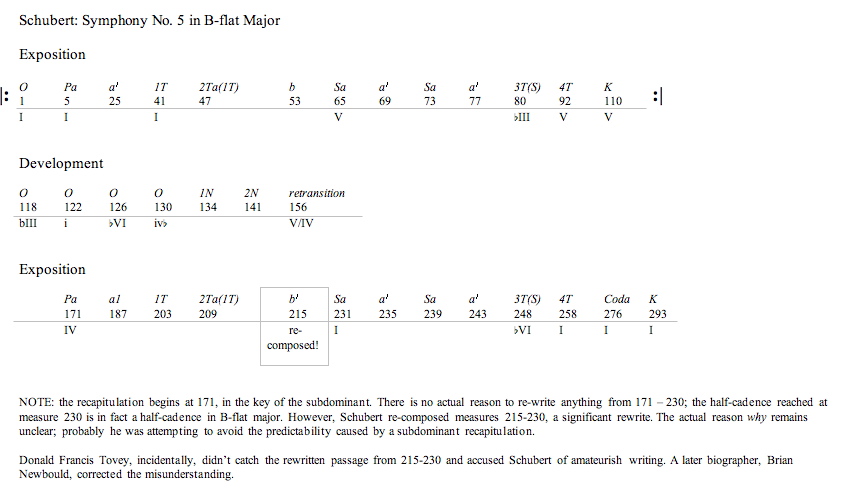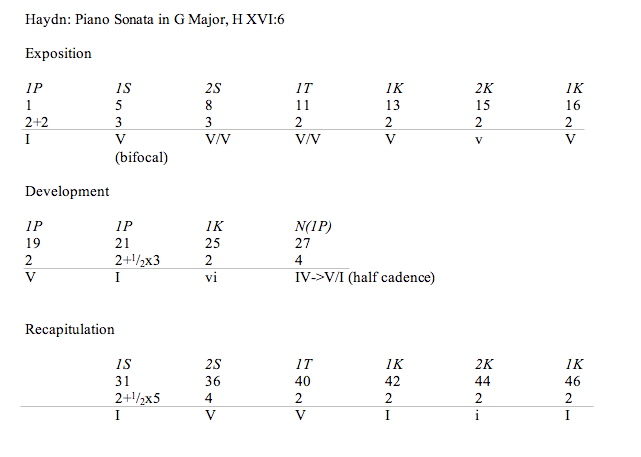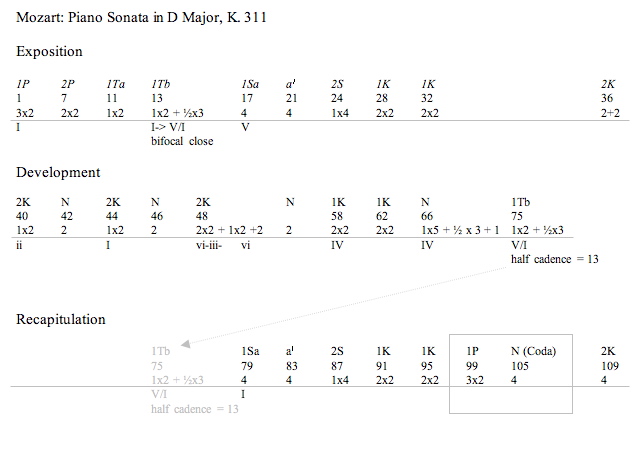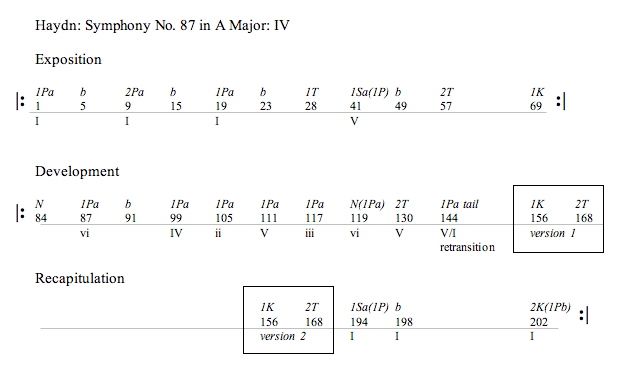Sonata Form: The Recapitulation
I. Recapitulation in elementary texts
II. Recapitulation "Shortcuts"
III. The "hinge" from development to recapitulation
IV. Vague beginnings to a recapitulation
I. Recapitulation in elementary texts
We are taught, in the very basic textbooks, that the recapitulation repeats the exposition, but with the first transitional passage so altered so as to remain in the original tonic key, rather than being stated in the dominant (or some other secondary) key. There are actually numerous sonata form movements which actually do this, so it isn't at all far-fetched. However, as with so many other aspects of sonata form, there are abundant examples of recapitulations which don't behave this way at all. We'll take a look at some of the aspects of sonata form recapitulations that so often make the recap the most interesting part of the sonata form to examine.
II. Recapitulation “Shortcuts”
A. The idea here is to avoid the period of recomposition in the recapitulation—i.e., the primary modulation. Since the recap will not modulate, it is necessary to rewrite this section of the exposition pretty dramatically to make it work in the recapitulation.
B. Sometimes composers in a hurry use one of the ‘shortcut’ techniques for the explicit purpose of making the recapitulation easy to write—somehow avoid the transitional passage, and transpose everything originally written in the secondary key to the primary key. However, in other cases, composers will treat these ‘shortcuts’ as interesting musical challenges, or will employ them for reasons other than that of convenience.
C. The “degenerate” recapitulation begins on the subdominant. Thus one can theoretically write a recapitulation by: 1) transposing the primary group and bridge down a fifth from the original—and thus it will wind up in the tonic and 2) transposing the secondary group into the tonic. This way you could write an entire recap without doing any re-composing (thinking) at all. However, when good composers write in such a way, they usually rewrite it anyway.
1. Mozart: Pf Sonata in C Major K 545 (click here for the score) (click here for a recording)
This is an example of a recapitulation beginning in the subdominant, but all isn't quite as simple as might seem. Examine the recapitulation carefully--it isn't quite 'in synch' with the exposition. Look at measures 50 - 53 in the recapitulation; there is no equivalent to those in the exposition. (click here for a score with aligned exposition and recapitulation.)
Question: why is there this difference? If the idea of starting a recapitulation on the subdominant is to avoid any recomposition in the recapitulation, why did Mozart recompose this passage? You don't get any points at all if your answer is "because he thought it was more interesting" or "stroke of genius" or anything like that. There's a solid reason for this. Don't look ahead at the answer until you've given it plenty of thought.
**************
Here's the answer...
The source of the 4-measure addition in the recapitulation is measures 12-13 in the exposition. Here we find the 'bifocal close' that I've mentioned before. The piece moves to a half-cadence, and then continues on in the key of the dominant as though there had been a modulation when in fact there has been no such modulation.
Normally, this means that the recapitulation can start in the tonic key and proceed up to the point of the bifocal close as an exact copy of the exposition. From that point onwards, the material in the exposition is simply transposed down a fifth to the tonic, and we continue onwards in the tonic key, only transposing the material in the exposition but not re-composing in any way.
However, in this movement, Mozart begins the recapitulation in the subdominant--which means that if he repeats the first part of the exposition verbatim (but transposed to the subdominant key), then the half-cadence at the equivalent of measure 12 (which is measure 57) will be a half-cadence in F Major--ie., a C Major chord, which will create a very problematic move into the secondary theme as we hear a half-cadence go completely unresolved.
As a result, Mozart was obliged to rewrite the material leading up to the bifocal close: starting at measure 50 of the recapitulation he expands theme 1T with yet more sequential movement, and then is able to repeat the material in the exposition from 9 - 12 verbatim in the recapitulation (note in the aligned score how measures 9 - 12 are the same as measure 54 - 57.) As a result, he is at a half-cadence at the dominant, and can continue onwards just as though he had begun the exposition in C Major.
So one more question remains: why did he, then, begin the recapitulation on the subdominant instead of in the tonic? The only really plausible answer is that this represents yet another solution to the nagging problem of the bifocal close--that is, the sheer tedium that results in the recapitulation because of the bifocal close's predictability. So in using this "degenerate" recapitulation form, Mozart is actually providing a clever and resourceful solution to a thorny problem.
2. Schubert: Symphony No. 5

We can see in the above chart that Schubert has actually rewritten part of the recapitulation in comparison to the exposition, even though he didn’t have to do this. (Tovey, incidentally, puts his foot in his mouth about this, not noticing the re-write.)
D. Recapitulation resulting from a bifocal close in the exposition
1. In theory, one could write the primary group with no transposition, and then transpose everything from the secondary group onwards into the tonic; sometimes composer do that, but other times it will be used as a compositional challenge.
2. I have already spoken about this concerning the exposition—see the remarks about Haydn’s first symphony.
E. Binary Sonata Form
1. The primary theme is altogether skipped in the recap, which begins either with 2P or some later theme. Haydn Sonata XVI:6 in G major is a good example. The development is quite short, and makes use of 1P, and so leaving it out of the opening of the opening of the recap is probably a good idea, to avoid tedium. Click here for a recording.

2. Fairly common in earlier sonata forms. Stamitz: Mannheim Symphony in B-flat Major. In such early forms, the recapitulation tends to be more harmonic than melodic—there might even be barely-recognized material in the recapitulation. Click here to view the score.
F. Mirror Recapitulations: the position of P and S themes is reversed—meaning that there may be absolutely no rewriting necessary in the recapitulation, beyond transposing the S -- K section into the primary key.
1. Mozart Sonata in D Major K 311

In this movement, a bifocal close at measure 16 introduces the secondary theme. The same figure is found at the very end of the development, at measure 78, which then continues onwards with the recapitulation starting with 1S. However, the 'skipped' 1P theme is found at the end of the recapitulation, after the 1K theme, and introduces a coda--inserted before the final 2K theme.
2. Haydn Symphony 87 Last Movement

This movement is challenging, to say the least. It's strongly monothematic -- even the K theme has strong connections with 1P. More to the point is the situation towards the end of the development and the beginning of the recap: we're not absolutely sure where one begins and the other leaves off. There is a clear retransition beginning at measure 144, to be sure. But at measure 156 there is a clear return to the tonic, and a recognizable theme, but the theme is 1K! After a further period of development, we hear a solid return to 1S (which is 1P), in the tonic key, and that seems like the recapitulation as well. However, the movement is almost over--what follows is 2K. So perhaps the recap is at 156 and perhaps it is at 194. But more to the point, this is a great example of the way the ideas of "development" and "recapitulation" can get in our way, really, more than helping us.
III. The ‘hinge’ from development to recapitulation: (click the links to hear them)
A. Can be thoroughly predictable: Haydn Symphony 53 in which a descending fifths sequence, based on the main melody, leads us inexorably into the recap. This is the sort of writing you do when you are being popular, and not very subtle. It isn’t bad writing by any means, but doesn’t challenge the listener particularly.
B. Big Dominant, Small Tonic (Mozart’s preferred)
Note how a very long dominant pedal is sustained before the arrival into the tonic—this is a typical procedure for Mozart, and later on for Beethoven.
Here the dominant is almost explosive, but there is the longish pedal—including the timpani.
C. Small Dominant, Big Tonic (Haydn before mid 1780s)
The end of the development is an intervening Andante section, which doesn’t even state the dominant at all, just the vii7.
Taken out of context (it’s in B-flat major) this sounds like “big dominant”—until we realize that the dominant being stressed is an applied dominant (V/vi) and the real dominant (an F Major chord) is only briefly stated in one measure before going into the recap.
IV. Vague Beginnings to a Recapitulation
A. Haydn Symphony No. 81, I
1. The big question is: where does the recap begin?
2. The main theme itself, as heard at the beginning, contains quite a lot of harmonic ambiguity as it immediately feints towards the subdominant. So that ambiguity becomes the seed of a greater ambiguity about the return to the recapitulation.
3. It almost sounds like we’re going to conclude the development at 110, but while the thematic return seems to be under way, the harmonic return hasn’t happened.
4. Measure 124 is really the first unambiguous place where we’re truly back in the tonic—but the main theme does appear at the end of the piece, as a kind of mirror recapitulation. I would indeed classify this as a mirror recapitulation, in fact.
B. Haydn Symphony No. 89, I. This shows us how any real stability can be postponed. The end of the development gives us an elided full cadence in the tonic at bar 111, but the F Major has acquired an E-flat within two measures and is off to the races again. Haydn avoids a cadence in the subdominant at 118, then writes a deceptive cadence at 122 to a half-cadence in 127. We aren’t completely stable yet: finally 136-138 there’s another half-cadence, and the second theme appears.
A. Haydn String Quartet Op 55 No 2, II. Here the material is monothematic in many ways and treated with a great deal of counterpoint. Thus the recap seems to be around 125—and there is a main theme here, but it’s almost buried within the surrounding sequential and contrapuntal texture. There is a clear thematic statement at 145—but now in F Major. This is a terrific example of the seamlessness of development and recapitulation, and the futility of expecting all recaps to follow the textbook models.
A. Beethoven Sonata Op. 31 No 2 Last Movement contains an excellent example.
B. Beethoven 7th Symphony, first movement, also contains an excellent—although rather short—example.
C. Characteristics
1. Generally appears soon after the beginning of the recap—as soon as the second phrase, in fact.
2. Can be short or very long.
3. Generally lowers harmonic tension by including an allusion to the subdominant or other left-leaning keys.